Harold and Maude
8.4 /10 1 Votes8.4
86% Rotten Tomatoes Genre Comedy, Romance Language English | 8/10 IMDb Music director Yusuf Islam Duration Country United States | |||||||||||||||||||||||||||||||||
 | ||||||||||||||||||||||||||||||||||
Release date December 20, 1971 (1971-12-20) Cast (Maude), (Harold Parker Chasen), (Glaucus), (Uncle Victor), (Sunshine Doré), (Priest) Similar movies Wilbur Wants to Kill Himself , The Last Emperor , Heat , Magnolia , 8½ , The Hours Tagline They were meant to be. But exactly what they were meant to be is not quite clear. | ||||||||||||||||||||||||||||||||||
Harold and maude 8 8 movie clip maude s 80th birthday 1971 hd
Harold and Maude is a 1971 American romantic black comedy drama directed by Hal Ashby and released by Paramount Pictures. It incorporates elements of dark humor and existentialist drama, with a plot that revolves around the exploits of a young man named Harold (Bud Cort) intrigued with death. Harold drifts away from the life that his detached mother (Vivian Pickles) prescribes for him, and slowly develops a strong friendship, and eventually a romantic relationship, with a 79-year-old woman named Maude (Ruth Gordon) who teaches Harold about living life to its fullest and that life is the most precious gift of all.
Contents
- Harold and maude 8 8 movie clip maude s 80th birthday 1971 hd
- Harold and maude 1 8 movie clip harold meets maude 1971 hd
- Plot
- Cast
- Production
- Critical response
- Home media
- Accolades
- Music
- 1972 soundtrack
- 2007 soundtrack
- Adaptations
- Unproduced sequel and prequel
- References
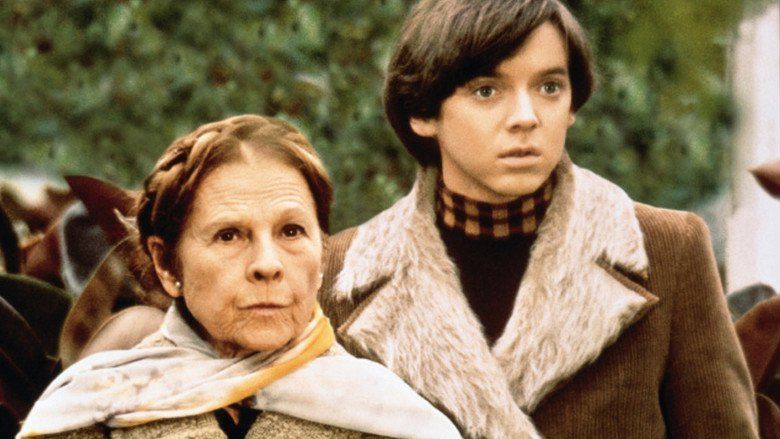
The film was based on a screenplay written by Colin Higgins and published as a novel in 1971. Filming locations in the San Francisco Bay Area included both Holy Cross Cemetery and Golden Gate National Cemetery, and the ruins of the Sutro Baths.

Critically and commercially unsuccessful when originally released, the film developed a cult following and in 1983 began making a profit. The film is ranked number 45 on the American Film Institute's list of 100 Funniest Movies of all Time and was selected for preservation in the National Film Registry of the Library of Congress in 1997, for being "culturally, historically or aesthetically significant". The Criterion Collection special edition Blu-ray and DVD were released June 12, 2012.
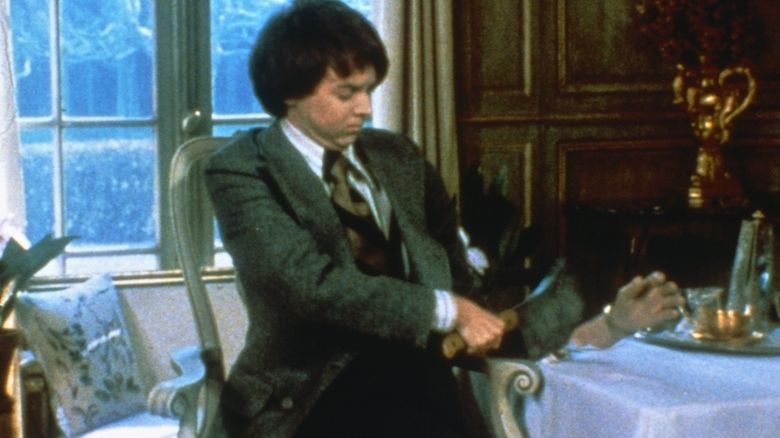
Harold and maude 1 8 movie clip harold meets maude 1971 hd
Plot
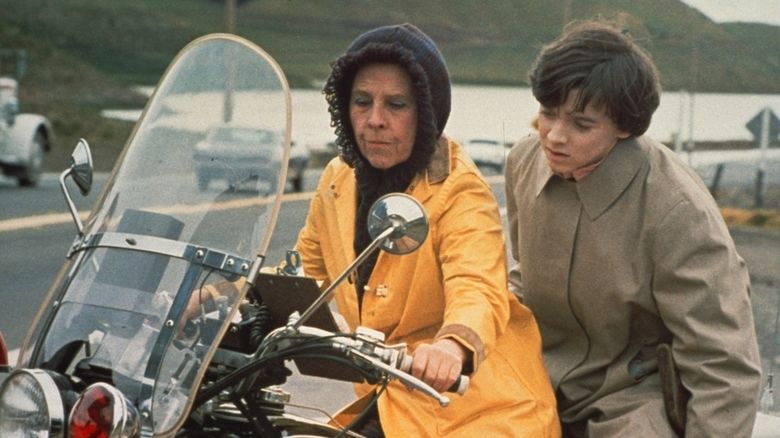
Harold Chasen (Bud Cort) is a young man obsessed with death. He stages elaborate fake suicides, attends funerals and drives a hearse, all to the chagrin of his socialite mother (Vivian Pickles). She sets him up appointments with a psychiatrist, but the doctor is befuddled by his case and fails to get Harold to talk about his real emotions.
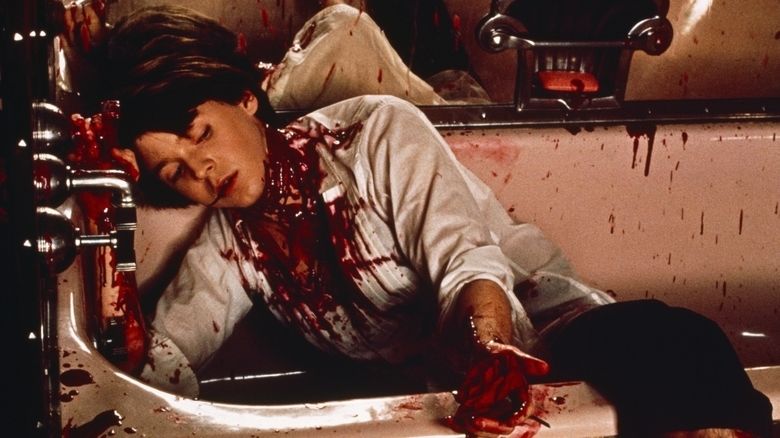
At another stranger's funeral service, Harold meets Maude (Ruth Gordon), a 79-year-old woman who shares Harold's hobby of attending funerals. He is entranced by her quirky outlook on life, which is bright and excessively carefree in contrast with his morbidity. The pair form a bond and Maude shows Harold the pleasures of art and music (including how to play banjo), and teaches him how to "[make] the most of his time on earth". Meanwhile, Harold's mother is determined, against Harold's wishes, to find him a wife. One by one, Harold frightens and horrifies each of his appointed dates, by appearing to commit gruesome acts such as self-immolation, self-mutilation and seppuku. She tries enlisting him in the military instead, but he deters his recruiting officer uncle by staging a scene in which Maude poses as a pacifist protester and Harold seemingly murders her out of militaristic fanaticism.
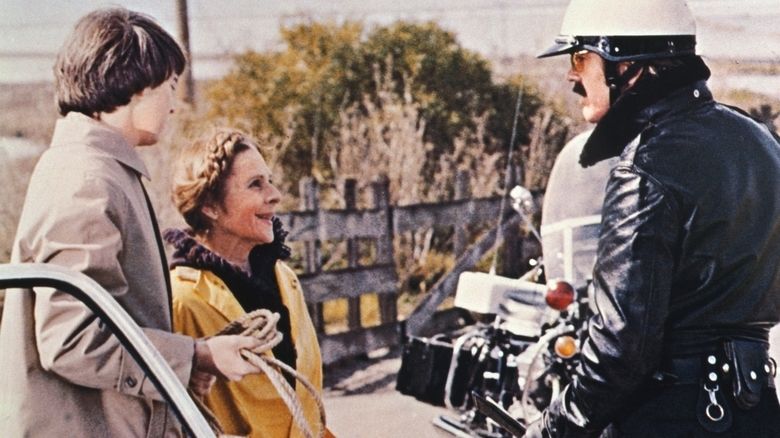
When Harold and Maude are talking at her home he tells her, without prompting, the motive for his fake suicides: When he was at boarding school, he accidentally caused an explosion in his chemistry lab, leading police to assume his death. Harold returned home just in time to witness his mother react to the news of his death with a ludicrously dramatized faint. As he reaches this part of the story, Harold bursts into tears and says, "I decided then I enjoyed being dead."
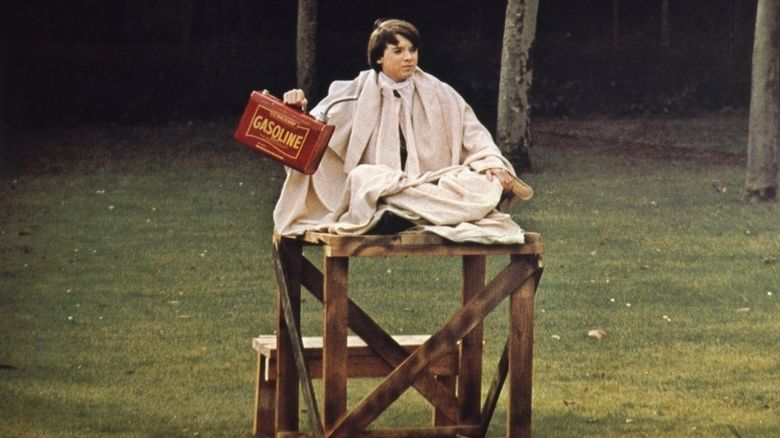
As they become closer, their friendship soon blossoms into a romance and Harold announces that he will marry Maude, resulting in disgusted outbursts from his family, psychiatrist, and priest. Maude's 80th birthday arrives and Harold throws a surprise party for her. As the couple dance, Maude tells Harold that she "couldn't imagine a lovelier farewell". Confused, he questions Maude as to her meaning and she reveals that she has taken an overdose of sleeping pills and will be dead by morning. She restates her firm belief that eighty is the proper age to die.

Harold rushes Maude to the hospital, where she is treated unsuccessfully and dies. In the final sequence, Harold's car is seen going off a seaside cliff but after the crash, the final shot reveals Harold standing calmly atop the cliff, holding his banjo. After gazing down at the wreckage, he dances away, picking out on his banjo Cat Stevens' "If You Want to Sing Out, Sing Out".
Cast
Director Hal Ashby appears in an uncredited cameo, watching a model train at an amusement park. The amusement park is Santa Cruz Beach Boardwalk (California USA) / Penny Arcade.
Production
UCLA student Colin Higgins wrote Harold and Maude as his master’s thesis. While working as producer Edward Lewis' pool boy, Higgins showed the script to Lewis's wife, Mildred. Mildred was so impressed that she got Edward to give it to Stanley Jaffe at Paramount. Higgins sold the script with the understanding that he would direct the film but he was told he wasn't ready, after tests he shot proved unsatisfactory to the studio heads. Ashby would only commit to directing the film after getting Higgins' blessing and then, so Higgins could watch and learn from him on the set, Ashby made Higgins a co-producer. Higgins says he originally thought of the story as a play. It then became a 20-minute thesis while at film school. After the film came out, the script was turned into a novel then a play, which ran for several years in Paris.
Ashby felt that Maude should ideally be European and his list of possible actresses included dames Peggy Ashcroft, Edith Evans, Gladys Cooper and Celia Johnson as well as Lotte Lenya, Luise Rainer, Pola Negri, Minta Durfee and Agatha Christie. Ruth Gordon indicated that in addition she heard that Edwige Feuillere, Elisabeth Bergner, Mildred Natwick, Mildred Dunnock and Dorothy Stickney had been considered.
For Harold, in addition to Bud Cort, Ashby considered all promising unknowns, Richard Dreyfuss, Bob Balaban and John Savage. Also on his list were John Rubinstein, for whom Higgins had written the part and then up-and-coming British pop star Elton John, whom Ashby had seen live and hoped would also do the music.
Anne Brebner, the casting director, was almost cast as Harold's mother, when Vivian Pickles was briefly unable to do the role.
Critical response
Harold and Maude received mixed reviews, with several critics being offended by the film's dark humor. Roger Ebert, in a review dated January 1, 1972, gave the film 1 and a half out of 4 stars. He wrote, "And so what we get, finally, is a movie of attitudes. Harold is death, Maude life, and they manage to make the two seem so similar that life's hardly worth the extra bother. The visual style makes everyone look fresh from the Wax Museum, and all the movie lacks is a lot of day-old gardenias and lilies and roses in the lobby, filling the place with a cloying sweet smell. Nothing more to report today. Harold doesn't even make pallbearer." Vincent Canby also panned the film, stating that the actors "are so aggressive, so creepy and off-putting, that Harold and Maude are obviously made for each other, a point the movie itself refuses to recognize with a twist ending that betrays, I think, its life-affirming pretensions."
The reputation of the film has increased greatly; Rotten Tomatoes, which labeled the film as "Certified Fresh", gave it a score of 86% based on 42 reviews, with an average score of 7.6/10. A consensus on the site read, "Hal Ashby's comedy is too dark and twisted for some, and occasionally oversteps its bounds, but there's no denying the film's warm humor and big heart." In 2005, the Writers Guild of America ranked the screenplay #86 on its list of 101 Greatest Screenplays ever written. Sight & Sound magazine conducts a poll every ten years of the world's finest film directors, to find out the Ten Greatest Films of All Time. This poll has been going since 1992 and has become the most recognised poll of its kind in the world. In 2012, Niki Caro, Wanuri Kahiu and Cyrus Frisch voted for "Harold and Maude". Frisch commented: "An encouragement to think beyond the obvious!" In 2017, Chicago Tribune critic Mark Caro wrote a belated appreciation, "I’m sorry, Harold and Maude, for denying you for so long. You’re my favorite movie once again."
Home media
On June 12, 2012, The Criterion Collection released Harold and Maude for Region 1 on DVD and Blu-ray, both of which includes a collection of audio excerpts of director Hal Ashby from January 11, 1972 and of screenwriter Colin Higgins from January 10, 1979, a new video interview with Yusuf/Cat Stevens, a new audio commentary by Ashby biographer Nick Dawson and producer Charles B. Mulvehill, and a booklet which includes a new film essay by film and television critic Matt Zoller Seitz. Exclusive to the Blu-ray edition are a new digital restoration of the film with uncompressed monaural soundtrack and an optional remastered uncompressed stereo soundtrack. Other exclusives are a New York Times profile of actress Ruth Gordon from 1971, an interview from 1997 with actor Bud Cort and cinematographer John Alonzo, and an interview from 2001 with executive producer Mildred Lewis.
Accolades
Harold and Maude is #45 on the American Film Institute’s list of 100 Years... 100 Laughs, the list of the top 100 films in American comedy. The list was released in 2000. Two years later, AFI released the list AFI's 100 Years... 100 Passions honoring the most romantic films for the past 100 years, Harold and Maude ranked #69. In September 2008, Empire listed Harold and Maude as #65 in Empire's 500 Greatest Movies of All Time. Entertainment Weekly ranked the film #4 on their list of “The Top 50 Cult Films.”
In June 2008, AFI revealed its "Ten Top Ten"—the best ten films in ten "classic" American film genres—after polling over 1,500 people from the creative community. Harold and Maude was acknowledged as the ninth best film in the romantic comedy genre.
The film is recognized by American Film Institute in these lists:
At the 29th Golden Globe Awards, Bud Cort and Ruth Gordon received a nomination for Best Actor and Best Actress in a Musical or Comedy film, respectively.
Music
The music in Harold and Maude was composed and performed by Cat Stevens. He had been suggested by Elton John to do the music after John had dropped out of the project. Stevens composed two original songs for the film, "Don't Be Shy" and "If You Want to Sing Out, Sing Out" and performed instrumental and alternate versions of the songs "On the Road to Find Out", "I Wish, I Wish", "Miles from Nowhere", "Tea for the Tillerman", "I Think I See the Light", "Where Do the Children Play?" and "Trouble" which were either on the album Mona Bone Jakon or Tea for the Tillerman. Those albums had been released before the film. "Don't Be Shy" and "If You Want to Sing Out, Sing Out" were not released on an album, until his 1984 compilation Footsteps in the Dark: Greatest Hits, Vol. 2.
There is some additional non-Cat Stevens music in the film. "Greensleeves" is played on the harp during dinner. During the scene where Harold is floating face-down in the swimming pool, the opening bars of Tchaikovsky's Piano Concerto No. 1 are heard. A marching band is also heard playing a march titled "The Klaxon" by Henry Fillmore outside the church following a funeral.
1972 soundtrack
The first soundtrack was released in Japan in 1972 on vinyl and cassette, (A&M Records GP-216). It omitted the two original songs and all instrumental and alternate versions of songs and was generally composed of re-released material that was in the film, along with five songs that were not in the film.
- "Morning Has Broken" (not in the film)
- "Wild World" (not in the film)
- "I Think I See the Light"
- "I Wish, I Wish"
- "Trouble"
- "Father and Son" (not in the film)
- "Miles from Nowhere"
- "Lilywhite" (not in the film)
- "Where Do the Children Play?"
- "On the Road to Find Out"
- "Lady D'Arbanville" (not in the film)
- "Tea for the Tillerman"
2007 soundtrack
The second soundtrack was released in December 2007, by Vinyl Films Records, as a vinyl-only limited-edition release of 2,500 copies. It contained a 30-page oral history of the making of the film, the most extensive series of interviews yet conducted on Harold and Maude.
- "Don't Be Shy"
- "On the Road to Find Out"
- "I Wish, I Wish"
- "Miles from Nowhere"
- "Tea for the Tillerman"
- "I Think I See the Light"
- "Where Do the Children Play?"
- "If You Want to Sing Out, Sing Out"
- "If You Want to Sing Out, Sing Out (banjo version)"—previously unreleased
- "Trouble"
- "Don't Be Shy (alternate version)"—previously unreleased
- "If You Want to Sing Out, Sing Out (instrumental version)"—previously unreleased
- "Don't Be Shy (demo version)"—previously unreleased
- "If You Want to Sing Out, Sing Out (alternative version)"—previously unreleased
Adaptations
Colin Higgins later adapted the story into a stage play. The original Broadway production, starring Janet Gaynor as Maude and Keith McDermott as Harold, closed after four performances in February 1980.
A French adaptation for television, translated and written by Jean-Claude Carrière, appeared in 1978. It was also adapted for the stage by the Compagnie Viola Léger in Moncton, New Brunswick, starring Roy Dupuis.
Unproduced sequel and prequel
Higgins expressed interest in 1978 about both a sequel and prequel to Harold and Maude. The sequel, Harold's Story, would have Cort portray Harold's life after Maude. Higgins also imagined a prequel showing Maude's life before Harold, Grover and Maude had Maude learning how to steal cars from Grover Muldoon, the character portrayed by Richard Pryor in Higgins' 1976 film Silver Streak. Higgins wanted Gordon and Pryor to reprise their roles.
References
Harold and Maude WikipediaHarold and Maude IMDbHarold and Maude Rotten TomatoesHarold and Maude themoviedb.org
